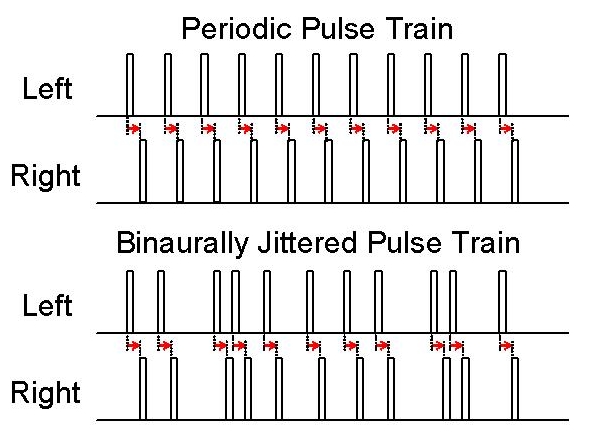Recovery from Binaural Adaptation in Cochlear Implant Listeners (ITD Jitter CI)
Objective
The sensitivity of normal hearing listeners to interaural time differences (ITD) in the envelope of high-frequency carriers is limited with respect to the envelope modulation rate. Increasing the envelope rate reduces the sensitivity, an effect that has been termed binaural adaptation (Hafter and Dye, 1983). Cochlear implant (CI) listeners show a similar limitation in ITD sensitivity with respect to the rate of unmodulated pulse trains containing ITD. Unfortunately, such high rates are needed to appropriately sample the modulation information of the acoustic signal. This study tests the ideas that (1) similar "binaural adaptation" mechanisms are limiting the performance in both subject groups, (2) the effect is related to the periodicity of pulse trains, and (3) introducing jitter (randomness) into the pulse timing causes a recovery from binaural adaptation and thus improves ITD sensitivity at higher pulse rates.
Method and Results
These ideas have been studied by testing the ITD sensitivity of five CI listeners. The parameters' pulse rate, amount of jitter (where the minimum represents the periodic condition), and ITD were all varied. We showed that introducing binaurally synchronized jitter in the stimulation timing causes large improvements in ITD sensitivity at higher pulse rates (? 800 pps). Our experimental results demonstrate that a purely temporal trigger can cause recovery from binaural adaptation.
Application
Applying binaurally jittered in stimulation strategies may improve several aspects of binaural hearing in bilateral recipients of CIs, including localization of sound sources and speech segregation in noise.
Funding
Internal
Publications
- Laback, B., and Majdak, P. (2007). Binaural jitter improves interaural time-difference sensitivity of cochlear implantees at high pulse rates, Proc Natl Acad Sci USA (PNAS) 105, 2, 814-817.
- Laback, B., and Majdak, P. (2008). Reply to van Hoesel: Binaural jitter with cochlear implants, improved interaural time-delay sensitivity, and normal hearing, letter to Proc Natl Acad Sci USA 12, 105, 32.
- Laback, B., and Majdak, P. (2007). Binaural stimulation in neural auditory prostheses or hearing aids, provisional US und EP patent application (submitted 20.06.07).
